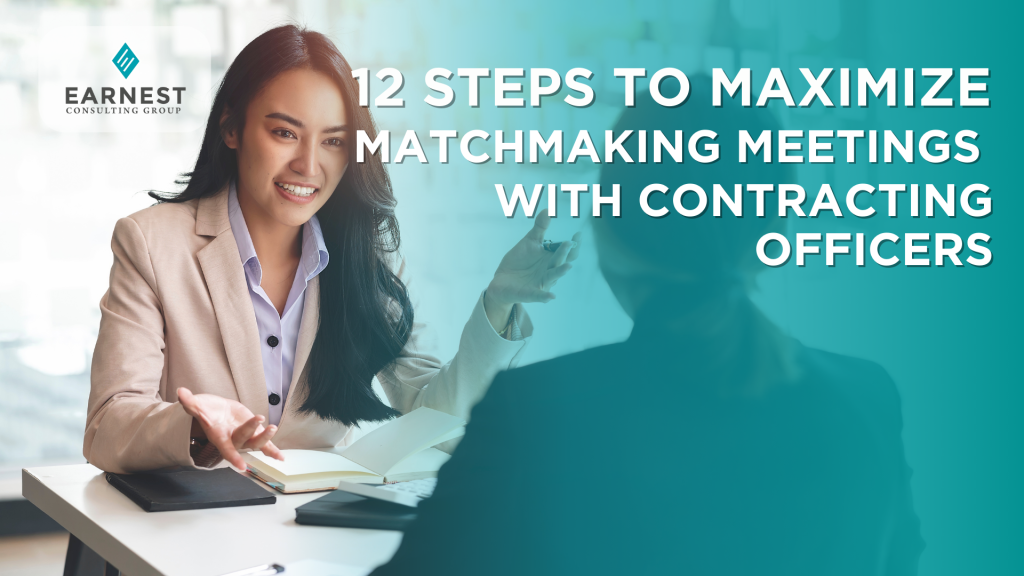12 Steps to Maximize Matchmaking Meetings with Contracting Officers
September 17, 2024 | Government
Matchmaking meetings with government procurement officials are a golden opportunity to get in front of decision-makers who can help move the needle for your business. To make the most of these meetings, you must be strategic, prepared, and focused on the right steps, from sign-up to wrapping up the meeting. Here’s your game plan:
1. Sign Up Early and Strategically
The moment matchmaking opens, jump on it! These slots fill up fast, and the best opportunities go quickly. But don’t just sign up with anyone—make sure the procurement official buys what you sell. A little research goes a long way here. Look up the agency’s recent purchases or contracting history to ensure they’re in the market for what you offer. If they’re not buying what you’re selling, move on. Also, focus on those who haven’t returned your emails or phone calls.
2. Prep Like a Pro
Before the meeting, fill out any required matchmaking portals and do your homework. Understand the agency’s mission, current contracts, upcoming needs, and procurement priorities. Research their pain points so you can steer the conversation in a way that shows how you’re the solution they’ve been looking for. Prepping also includes rehearsing in the mirror or with a trusted mentor or colleague. The more you reps you get the more at ease you’ll feel in the meeting.
3. Relax and Show Confidence
Relax! If you’re nervous or look desperate, it will show—and that can turn people off. Confidence is key. If you don’t feel confident, do something to calm yourself before the meeting. Try deep breathing exercises or write down everything you’re afraid might happen on a piece of paper, then wad it up and throw it away. These simple exercises can help get the jitters out and keep you focused.
4. Dress Professionally—but Be Yourself
You don’t need to be the best-dressed person in the room, but your outfit should reflect professionalism. Don’t turn your attire into a costume to project something you’re not. If you’ve never worn a three-piece suit, don’t buy one for this meeting. On the flip side, if your usual go-to is jeans and a T-shirt, consider stepping it up a notch. The government employee culture hasn’t gone casual like some parts of the commercial sector, so aim for a polished appearance that still feels like you.
5. Nail Your Pitch—But Don’t Sell
Once you’re in the room (or on the call), get to the point quickly. You’ve only got a few minutes to make an impression, so make them count. Highlight your unique value proposition using metrics that highlight your experience. However, this isn’t the time for a hard sell—it’s the time to begin building a relationship. Show genuine interest in them. Ask where they live, if they have family, or what they’re passionate about in their role. Making them the spotlight can build rapport and lay the foundation for future opportunities.
6. Get Them Talking: Understand Their Challenges
Turn the tables and get them talking. Ask questions like, “What are your biggest challenges right now?” or “Where do you see the most significant gaps in your current operations?” This not only positions you as a partner who cares about their needs but also gives you valuable insights to tailor your response. Be genuinely interested in their responses and ready to pivot based on what they share. This builds rapport and shows that you’re not just there to sell but to solve their problems. Have a list of questions prepared before your meeting.
7. Don’t Bring Your Capabilities Statement
Leave the capabilities statement at home. Instead, send it afterward for two reasons: First, you can tailor it to your discussion, making it more relevant and impactful. Second, it gives you another reason to follow up and keep the conversation going. If they specifically ask for it, just respond, “I’m not going to make you carry this back home with you. I’ll send it to you via email.” This will give you time to tailor it and an excellent reason to follow up.
8. Bring Something Memorable to the Table
Find a way to stand out. Bring a data point, a success story, or a unique solution that sticks with them long after the meeting. Memorability matters when they’re meeting with dozens of companies—make sure they remember you.
9. Have a Follow-Up Plan Ready
Don’t let the conversation end when the meeting does. Plan your follow-up before you even have the meeting. Whether it’s sending additional information, a thank-you email, or a customized proposal, show you’re committed to building a relationship and adding value. Don’t send a generic capabilities statement; as stated above, tailor your follow-up to mirror the points discussed.
10. Slow Down and Be Empathetic
These meetings can feel like a sprint but don’t rush. Slow down and show empathy. Understand that procurement officials are often juggling many priorities and have their scripts and pressures. Being patient and flexible can help you stand out in a sea of aggressive vendors.
11. Avoid Common Pitfalls
Don’t mix up names or companies—always double-check your details. And be prepared for the unexpected; meetings can change at a moment’s notice. Stay flexible, keep your cool, and be ready to adapt as needed.
12. Close Strong
Wrap up the meeting with a clear next step. Make sure they know what to expect from you and what you’d like in return. Whether it’s scheduling a follow-up call, providing more detailed information, or simply thanking them for their time, leave the door open for continued communication.
By following these 12 steps, from signing up to closing the meeting, you can maximize every matchmaking opportunity and position yourself as a valuable partner in the government marketplace. Remember, it’s not just about getting in the room; it’s about owning the room with confidence, clarity, and a game plan that sets you apart.
« Back to Blog Home




